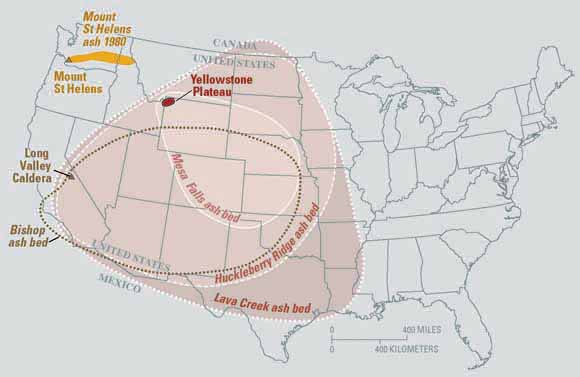American supervolcano
While we’re arguing about how much damage we’re doing to the planet based on junk science and fabricated data, Mother Earth just keeps on keeping on. From National Geographic’s Under Yellowstone:
The last three super-eruptions have been in Yellowstone itself. The most recent, 640,000 years ago, was a thousand times the size of the Mount St. Helens eruption in 1980. The pillar of ash rose some 100,000 feet, leaving a layer of debris across the West all the way to the Gulf of Mexico. Pyroclastic flows—dense, lethal fogs of ash, rocks, and gas, superheated to 1,470 degrees Fahrenheit—rolled across the landscape in towering gray clouds. The clouds filled entire valleys with hundreds of feet of material so hot and heavy that it welded itself like asphalt across the once verdant landscape. And this wasn’t even Yellowstone’s most violent moment. An eruption 2.1 million years ago was more than twice as strong, leaving a hole in the ground the size of Rhode Island.
Gases rising high into the stratosphere would have mixed with water vapor to create a thin haze of sulfate aerosols that dimmed sunlight, potentially plunging the Earth into years of ‘volcanic winter.’ According to some researchers, the DNA of our own species may pay witness to such a catastrophe around 74,000 years ago, when a supervolcano called Toba erupted in Indonesia. The ensuing volcanic winter may have contributed to a period of global cooling that reduced the entire human population to a few thousand individuals—a close shave for the human race.
Half the geysers on the planet are in Yellowstone. The hydrothermal features change constantly in temperature and behavior, with new ones popping up in the forests, spewing clouds of steam visible from airplanes, exuding vapors that have been known to kill bison on the spot.
Look at those numbers: one 2,100 thousand years ago; one 1,300 thousand years ago; and one 640 thousand years ago. That’s too few to see a pattern, especially because the big ones can wipe out evidence of previous ones, but… you know, that kinda looks like a pattern.
And when they say big, they mean big. The largest eruption spread ash throughout half of the United States Even the smallest covered about four states.
I hope we have enough money saved up to deal with nature’s super-tantrums when the first one finally occurs. At least this one shouldn’t be a problem. The next one’s not due for about 60,000 years, give or take a hundred thousand or so.
- Chiffon Margarine commercial (Mother Nature)
- “It’s not nice to fool mother nature.”
- Steam Explosions, Earthquakes, and Volcanic Eruptions—What’s in Yellowstone’s Future?: Jacob B. Lowenstern, Robert L. Christiansen, Robert B. Smith, Lisa A. Morgan, and Henry Heasler
- “Yellowstone, one of the world’s largest active volcanic systems, has produced several giant volcanic eruptions in the past few million years, as well as many smaller eruptions and steam explosions. Although no eruptions of lava or volcanic ash have occurred for many thousands of years, future eruptions are likely. In the next few hundred years, hazards will most probably be limited to ongoing geyser and hot-spring activity, occasional steam explosions, and moderate to large earthquakes.”
- Under Yellowstone: Joel Achenbach
- “Beneath Yellowstone Park a monstrous plume of hot rock is causing the earth to heave and tremble. Past volcanoes have erupted with a thousand times the power of Mount St. Helens. The future is anybody’s guess.” (Hat tip to Eugene Volokh at Volokh Conspiracy)
More end of the world
- The graphs of destruction
- Imagine a graph with two lines charted against the years: the resources needed to cause mass destruction, and the resources available to those who want to cause mass destruction. Those lines are dangerously close today.

